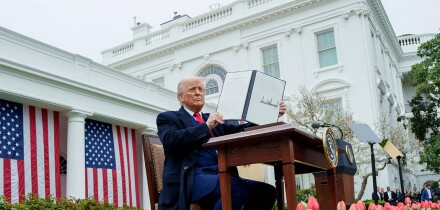There is no particular value at which a foreign exchange rate is stable. Twenty years ago, USD/GBP was reasonably stable at USD4, now it is considered reasonably stable at USD1.5. In contrast, interest rates in stable economies are rarely greater than 20% or less than 2%. There is an overwhelming tendency for interest rates to return to this stable area, and not to fly away to 70% or sink to -10%. This tendency to return to a certain region is known as mean reversion.
There are good and sound economic reasons for interest rates to be mean reverting. Essentially, very high or negative interest rates in the majority of economic models either lead to a downward economic spiral, or snap quickly back to more normal levels. Many models preclude negative or very high interest rates for this reason. Examples of unsustainably high interest rates which lead to breakdown have occurred several times this century. In an economy which is stable over a number of years, the only reasonable mathematical interpretation of interest rate behaviour is a mean reverting one.
Is mean reversion only a mathematical curiosity, or can it actually be of use? For exposure management, mean reversion can be very important. The risk or exposure of a deal depends on the future range of variation of the value of the deal, which in turn is dependent on the range of values taken by the underlying market rates on which the deal is based. Thus a crucial part of good exposure management is simulation of likely market rate levels. Usually a Monte Carlo-type method is used, and commonly the upper and lower bounds of the rate at a 95% confidence level are used as important parameters in deciding the risk of a deal.
It is easy to see why mean reversion is important, because without it, the risk on an interest rate-based deal will grow in proportion to the square root of the maturity date or length of the deal. With mean reversion, the risk will grow with the deal length out to about 10 years, and after then remain roughly unchanged, so there is little difference between a 20-year and a 30-year deal. Thus if mean reversion is included in exposure calculations, it becomes possible to accept many more deals with longer maturities.
The growing interest in long-dated derivatives means the edge given by the inclusion of mean reversion can be very important. Also, portfolio risk is becoming more carefully managed, with simulation of market and credit risk becoming more scientific. Including mean reversion in these calculations enables the portfolio manager to lower market risk in all but pure forex portfolios, and thus take on more business while maintaining risk at an acceptable level.
In the figure we give an example of the different types of rate evolution, with and without mean reversion. The graph shows the possible spread of values at a 95% confidence interval, for a normal (Gaussian) distribution and for a mean reverting system. It can be seen that after about 10 years, the mean reverting behaviour dominates the range of value or risk, while for smaller maturities mean reversion effects are not noticeable and the distribution is identical to a normal one.
It is interesting to note a historical interest rate time series may be fitted in different ways. It will often give a reasonable fit to a normal distribution, until it is realized that extrapolating into the future using this distribution gives an unreasonably large range of values. Fitting the time series to a mean reverting model will always give better results, unless the country's economy is unstable. It is of course important to have sufficient history--two or three years may be insufficient to show definite mean reverting effects.
A good example of a mean reverting model is the Vasicek model. Below we give the equation which governs evolution of interest rates under this model:
Here r is the short rate, r0 is the mean short rate, t is time, * is a volatility parameter and z governs the random motion. * is the mean reversion parameter.
Are there any dangers or additional risks involved in the incorporation of mean reversion into exposure management? The answer is no, as long as it is done intelligently. Obviously, if mean reversion is not present in a very volatile currency, then it should not be included. However, fitting past data from that currency to a mean reverting model will result in a value of zero for the mean reversion coefficient, and no mean reversion will be included in future simulations. Mean reversion should not be assumed to be present, but should always be tested for. In the future, increasingly competitive pricing and a more scientific approach to portfolio management will mean it will be very important to include this effect to remain at the cutting edge of financial management.
This week's Learning Curve was written by Jessica James, from First Chicago NBD's strategic risk management group in London.






